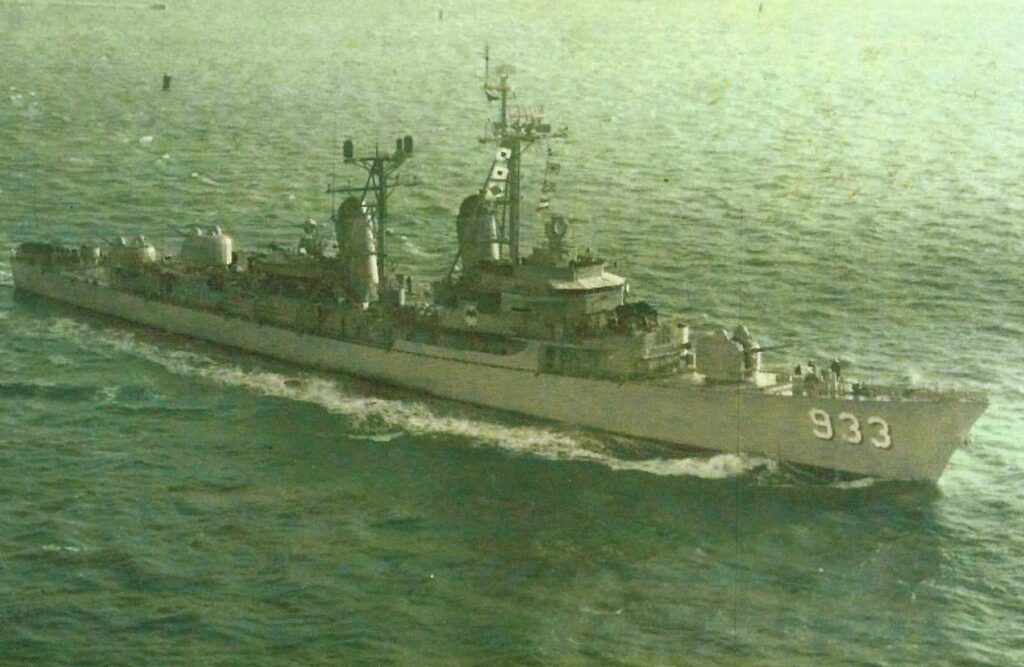
The SS Barry DD933, with Hopkinton’s Bill Hamilton aboard, played a role in a major tragedy in 1961.
This tale takes place a little farther from Hopkinton than my usual stories.
I was a third-class quartermaster aboard the SS Barry DD933. At sea, my duties while on watch consisted of helping the officers with navigation, keeping the bridge clean and keeping the ship’s log. The log was the legal record of everything that went on affecting the ship, like the direction and speed of the ship at all times, etc.
When the ship went on special details — going in and out of port, going alongside another ship at sea to refuel or replenish supplies, or battle stations — my job was steering the ship.
On the night of Jan. 15, 1961, we, along with another four destroyers, were on anti-submarine activities off the coast of Long Island, New York.
The weather was terrible. Winds were up to 80 mph, seas up to 70 feet, and there was a raging snowstorm.
We were in the Cold War period of our history. As a deterrent to a missile attack by Russia, the United States put up radar installations 70-100 miles off the East Coast. They were called “Texas Towers” because they resembled oil platforms off the coast of Texas.
Tower 4 was located about 70 miles east of Long Island. It was built on shore, towed out to sea and placed above the water on three steel legs that were anchored to the sea bottom.
Tower 4 had a history of structural damage and was known as “old shaky.” One leg had been damaged while being towed to its location. The whole structure also was damaged by Hurricane Donna the previous fall. The damage was scheduled to be repaired but had not been done.
After Hurricane Donna, consideration was given to vacate the facility until repairs could be made, but the government had decided against it, instead cutting the normal complement of men at the station from 51 to 28.
Earlier in the day, while helicopters still could get to the platform, permission was asked to abandon the facility but was denied.
Around 3 p.m., a loud “boom” was heard by the men on the tower, which meant a structural support on the tower had broken, and the tower started coming apart. The captain again radioed for permission to abandon, and this time it was granted. However, because of the weather conditions, helicopters could not fly, and there was no way to get the men off the tower.
I had just come on the 4-8 watch at 3:45 p.m. when the radioman came onto the bridge with a message for all ships in the area to proceed to the Tower 4 location to assist.
At 6:45 p.m., as we were on our way, we got a radio message from the tower that it was breaking up. That was the last message ever received from the tower.
We were about 20 miles away by then. We went to “special sea detail.” I went from on regular watch to steering the ship. We could do only 10-12 knots because of the conditions.
At 7:45 p.m., as we were nearing the tower, it disappeared from the radar. We got to the site within the hour and searched back and forth over where the tower had been. We searched for the rest of the night but never found anybody. In the morning, the storm had abated, the waves were down to about 15-20 feet, and visibility was decent as we continued searching. Only one body ever was found, by another ship.
Later in the day, we were ordered to resume our anti-submarine operation, but several other ships continued to search.
For a while, I thought a lot about the 28 men on the tower in that maelstrom we all were in. I was in a “safe” place, and they were facing sure death, with no hope for rescue.
My bunk was on the starboard side of the ship, below the waterline. I could lay in my bunk, put my hand on the 3/8-inch steel side of the ship and feel and hear the water rush past. On stormy nights, I would pray that none of the men building my ship had taken any shortcuts, nor had anyone ever skimped on any construction inspections.




















Enjoyed this! Good job Bill-you should write more often!